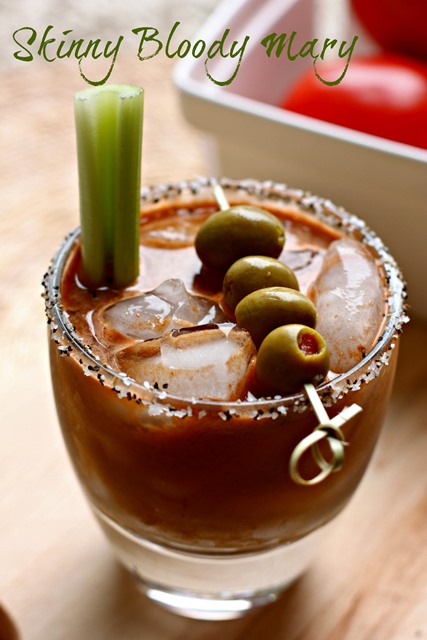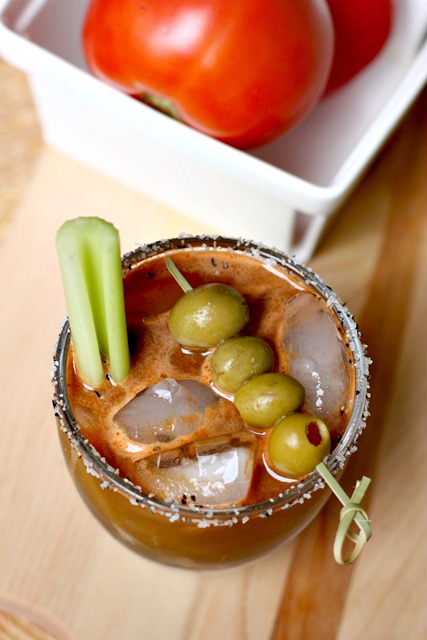I was asked by Williams-Sonoma to share my personal spin on the iconic Bloody Mary using freshly juiced tomatoes. Since my book has been out I’ve been answering a lot of questions about juicing, so I thought I would also share a few tips on juicing and juicers.
The very first thing I want to clear up (and what I get the most questions about) is the difference between juicing and blending. I explain this in my book, but let me break it down for you here, too. Simply put, juicing requires the use of a juicer. A juicer, unlike a blender, works by extracting the liquid part of fruit or veggies from the solid part, leaving behind what we call “pulp” (aka insoluble fiber). Please don’t get yourself into a frenzy over this fiber piece. If I had a nickel for every time I heard someone say that “there’s no fiber in juice” — well, you know the saying. In fact, I would love for you to stand up right now, wherever you are, and just start yelling very loudly hey everybody — there IS fiber in juice! Okay, that might be a little dramatic, but some days that’s how I feel. If you don’t believe me, let your juice sit on the counter or in the fridge for a few minutes and then look at it. What do you see? It’s the soluble fiber (not the insoluble kind) that is at the bottom of that glass. It’s also what makes the juice appear cloudy. So contrary to what you read and hear, there is soluble fiber in juice. But not a ton. Which makes it pretty darn easy for your body to absorb the juice and shuttle all those amazing vitamins, minerals, live enzymes and plant nutrients into your bloodstream almost instantly, giving you that jolt of energy that everyone talks about. And, depending on your juice ingredients, it can even be quite filling. This Bloody Mary was hearty, let me tell you! Why? Because this is what’s in it:
My Bloody Mary consists of 2 large tomatoes, 2 scallions, 1 lime, 2 stalks celery, 2 cups baby carrots (I didn’t have any whole carrots), and 1 head of Romaine lettuce. You could probably blend all this together as well, but it would be much thicker and not really drink-like. This is because blending is totally different than juicing. For one, no juicer is required…just a blender will do. For two, you’re not separating the liquid and fiber from the produce, you’re just blending everything up together, usually with some liquid, into a smoothie. So blending keeps all the fiber intact, which in turn requires your body to do a lot more work digesting. This slows down how fast the nutrients reach your cells and doesn’t give you that energy burst like juicing does. That being said, you can make a meal out of your smoothie by blending in nuts and nut butters, seeds, greens, yogurt, protein powder and many other fun stuff. This gives your smoothie an altogether different nutrient profile than you get from juice, and why they’re often used to replace a meal.
I also want to point out that there’s more to fruits and vegetables than just fiber. They are great sources of vitamins, minerals, antioxidants and other plant nutrients that are important in preventing disease and keeping us healthy. So as you can see, one is not better than the other. I blend and I juice and love them both. But generally speaking, juice is not a meal. It’s a supplement. As I discuss in my book, think of juicing as your daily (or weekly) multivitamin.
So how do you choose a juicer? There are quite a few to pick from. I use a Breville juicer at home. It’s not the best of the best, it’s very middle of the road, but it’s fast, easy to clean, and it makes a decent (even a bit pulpy) juice. These were my criteria. You may have different needs. If you need some help deciding, shoot me an email or ask me here on Facebook.
Here’s a quick low-down on the different types of juicers straight from my book:
Centrifugal Juicers
These are your “drink and go” juicers. They’re perfect for anyone new to juicing because they’re fast, easy to assemble and clean, and fit most any budget. These juicers work by forcing the produce down a shoot into a fast spinning disk blade that sits inside a mesh basket. The juice is then pushed through a fine strainer via centrifugal force into an external juice container.
Pros: easy to assemble and use; wide-mouthed produce shoot allows for less prep time chopping; works well with most fruits and non-leafy greens; least expensive; easy to clean, and widely available.
Cons: higher speed creates a more foamy juice; enzymes and nutrients are oxidized at a much faster rate; not suitable for juicing wheatgrass and leafy greens; produces the least amount of juice, and can leave behind a wet pulp; juice is best consumed immediately.
Masticating Juicers
These juicers may also be known as slow juicers, cold press, single gear, or single auger juicers. They work by grinding the produce through a super slow spinning auger (with no blades) that gently crushes and squeezes the juice from the produce. The process is slow, allowing for less oxidation and nutrient loss as compared with centrifugal juicers.
Pros: easy to assemble and use; well suited for juicing leafy greens, herbs, and sprouts; some are able to grind nuts and grains; higher juice yield and slower speed results in less oxidative damage and a higher nutrient content; produces less foam and separation compared to centrifugal juicers; can make juice in large batches for storage up to forty-eight hours with minimal nutrient loss.
Cons: slower speed means more time in the kitchen; more moving parts may take longer to clean; smaller produce shoot means more time chopping and prepping produce for juicing; more expensive than centrifugal juicers.
Twin Gear Juicers
These juicers might also be called dual-gear or triturating juicers and are second only to the hydraulic press in terms of quality and juice yield. They work by using two slow-moving spinning gears to squeeze and press the juice out of the produce and often contain magnets inside the gears to prolong nutrient retention. They come in electric and manual hand-crank versions which are designed specifically for juicing wheatgrass.
Pros: produces an excellent quality juice with high retention of nutrients; can juice most fruits and vegetables, leafy greens, sprouts, herbs and wheatgrass; can grind grains and nuts; can juice in large batches for storage up to forty-eight hours with minimal nutrient loss.
Cons: slower speed means more time in the kitchen; more moving parts may take longer to clean; more costly than masticating or centrifugal juicers; juices soft fruits like mango and pineapple poorly.
Hydraulic Press Juicers
These juicers are the cream of the crop! It produces the highest yield and highest quality juice. It works by slowly and gently pressing the juice out of the produce, leaving most of the nutrients intact.
Pros: excellent quality juice due to very little oxidation and nutrient degradation; can be used for most fruits and all vegetables, greens, herbs, and sprouts; can make large batches and store up to seventy-two hours.
Cons: slowest to juice; may be very loud; hardest to clean; significant investment; juices wheatgrass poorly.
You can also check out Williams-Sonoma for their juicers. They have a pretty solid selection of slow-type masticating and fast-type centrifugal juicers for purchase. They also sell the Vitamix and call it a “Whole Food Juicer” — I kind of like that but I really don’t think of my Vitamix as a juicer.
When I was whipping up this Bloody Mary I used my Green Mary Detox recipe from Skinny Juices as the base. To it I added some olive juice (what’s a bloody without olives?), Worchester sauce, horseradish and a very small dash of salt and pepper. Because my base already had so much flavor, I really didn’t need to add much else. Obviously there are a ton of ways you can customize a Bloody Mary, so have at it! Mine was actually a mocktail, since it did not contain any vodka.
Bloody Mary’s are just one fun drink you can make with your juicer. There are endless options for getting your juice on in creative ways. I love adding some texture to my drinks so many of my recipes include fun add-ins like pomegranates, grapes and cocoa nibs and I also love to add cinnamon and ginger to most of my juices.
Cheers!

Skinny Bloody Mary
Ingredients
- 2 big juicy tomatoes
- 2 stalks celery
- 1-2 scallions
- 2 large carrots or 2 cups baby carrots
- 1 head Romaine lettuce
- 1/4 tsp salt
- 1/4 tsp pepper
- 4 tsp olive juice
- 1 tsp prepared horseradish
- 2-3 tsp Worcestershire sauce
- 2 oz vodka optional
Instructions
- Run vegetables through juicer. Pour into pitcher and add remaining ingredients. Stir well. Adjust seasonings to taste.
- Makes 2 servings.

